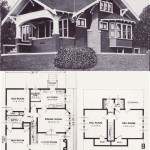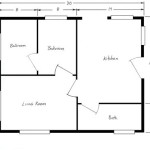How To Find The Floor Plan of a Property
Acquiring a property's floor plan is a crucial step in various situations, from interior design and renovation planning to property valuation and marketing. A floor plan provides a visual representation of a property's layout, dimensions, and the arrangement of rooms. It offers valuable insights into space utilization, structural elements, and potential for modifications. Locating these plans can sometimes be straightforward, while in other instances, it requires more extensive research and resourcefulness. This article will serve as a comprehensive guide to navigating the various avenues available for obtaining a property's floor plan.
The ease with which one can find a property's floor plan depends on several factors, including the age of the property, its location, and the availability of public records. Newly constructed properties often have floor plans readily available from the developer or builder. Older properties, however, may require more extensive investigation, potentially involving multiple sources and historical records. The following sections outline the most common and effective methods for locating a floor plan.
Checking Existing Documentation and Records
The first and often most fruitful approach involves examining existing documentation related to the property. This includes documents that may have been provided during the purchase or lease of the property, as well as records that might be stored elsewhere.
Specifically, the initial point of contact should be the current owner of the property. They may possess a copy of the original blueprints or floor plans provided by the builder or architect. Reviewing mortgage documents is also a viable strategy. Mortgage applications often require a property survey, which may include a basic floor plan. Leases, particularly for commercial properties, frequently contain detailed floor plans outlining the leased space and its dimensions. It’s crucial to remember that even seemingly insignificant documents should be examined, as even a simple brochure or marketing material from the property's initial sale might contain a floor plan.
Beyond personal records, homeowners should explore their own files for records of previous renovations or improvements. Any significant alteration to the property's structure would likely require the creation or modification of the existing floor plan. These altered plans are valuable resources for understanding the property's current layout, especially in comparison to earlier versions.
For recently constructed homes, the local home builders association sometimes maintains records of floor plans for the homes they have built. Contacting them may provide access to the plans or at least provide the name of the architectural firm which provided the design drawings.
Utilizing Online Resources and Databases
The internet can be a powerful tool in the search for a property's floor plan. Several online resources and databases specialize in property information and may contain floor plans.
Real estate websites, such as Zillow, Redfin, and Realtor.com, often include floor plans as part of their property listings. While not all listings include floor plans, it is a worthwhile first step, especially if the property has been recently listed for sale or rent. It’s essential to review archived listings as well. Even if the property is no longer actively for sale, older listings may still be accessible and contain valuable information. Similarly, architectural design websites often showcase floor plans for various types of properties. Searching these websites using the property's address or architectural style may yield results. Some websites offer floor plans for sale, particularly for popular architectural styles or model homes.
Public record databases maintained by local governments can also be a valuable resource. Many counties and municipalities now offer online portals where property records, including deeds, surveys, and building permits, can be accessed. These records may contain floor plans, especially if the property has undergone significant renovations or additions. It’s important to note that access to these databases may require registration or a fee. Furthermore, the level of detail and availability of information can vary significantly depending on the jurisdiction.
Furthermore, online forums and community groups focused on real estate or architecture can be valuable. Engaging with other enthusiasts or professionals in these forums may provide insights or leads on where to find floor plans for specific properties or architectural styles.
Contacting Local Authorities and Professionals
If the previous methods prove unsuccessful, contacting local authorities and professionals who specialize in property records and architectural design can be beneficial. These individuals and organizations possess in-depth knowledge of local regulations and resources.
Local building departments or planning offices are often repositories of property records, including building permits, surveys, and architectural plans. Requesting access to these records may require submitting a formal request and paying a fee. The process for obtaining these records can vary depending on the jurisdiction, so it is important to understand the specific requirements of the local government. Consultations with planning officials are also useful to understand any constraints or easements documented against the property which may affect your renovation or building plans.
Architects and designers are professionals who specialize in creating and interpreting floor plans. Hiring an architect or designer to recreate the floor plan of an existing property is an option, especially if no existing plans can be found. This process involves physically measuring the property and creating a detailed floor plan based on those measurements. This approach can be particularly valuable for older properties or those with unusual layouts. The cost of this service will vary depending on the size and complexity of the property. Similarly, professional surveyors are equipped to measure properties and create accurate site plans, which may include basic floor plan information. Surveyors are particularly useful for determining property boundaries and easements, which can be crucial for renovation or construction projects.
Another possible professional to engage is a real estate agent or broker specializing in the local area. They may have access to historical property records or contacts within the real estate industry who can assist in the search for a floor plan. Real estate professionals often maintain databases of property information, including floor plans, for properties they have previously sold or leased. Their expertise and network can prove invaluable in navigating the local property market and locating relevant records.
In conclusion, the process of locating a property's floor plan requires a systematic approach, beginning with an examination of existing personal records and progressing to online resources and local authorities. The specific methods employed will depend on the age, location, and history of the property. Persistence and a willingness to explore multiple avenues will increase the likelihood of success in obtaining the desired floor plan.

9 Ways To Find Floor Plans Of An Existing House Blueprints Archid

How To Find Property Lines And Keep From Calling An Expensive Surveyor Armchair Builder Blog Build Renovate Repair Your Own Home Save Money As Owner

How To Read House Plans Elevations

9 Ways To Find Floor Plans Of An Existing House Blueprints Archid

How To Find Building Plans For My House Architecture Design Plan

Where You Can Buy House Plans Live Home 3d

How To Read A Floor Plan With Dimensions Houseplans Blog Com

How To Read House Plans Elevations

How To Read A Floor Plan With Dimensions Houseplans Blog Com

Site Plans What They Are And How To Create One








